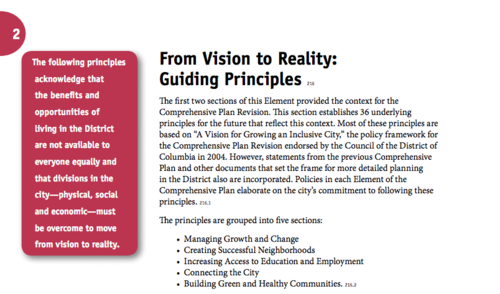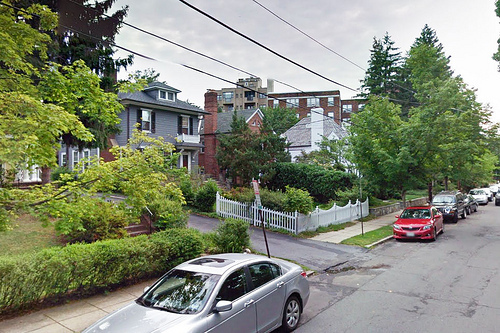33 pages after calling for a growing and inclusive city, DC’s Comprehensive Plan muddies that vision
Greater Greater Washington readers are reading the DC Comprehensive Plan together. Each week we discuss a section online. We’ll post a summary of each chapter and our participants’ thoughts about the changes we want to see in the upcoming amendment process.
DC’s 2005 Comprehensive Plan began with a strong and encouraging vision: building a growing and inclusive city. Just one chapter later, it lists a set of contradictory guiding principles that waffle between preserving the status quo and promoting inclusive growth. Oops.
A great vision gives great promise
DC’s 2005 Comprehensive Plan accurately forecast DC’s growth up to 2010, though the city has grown much faster than predicted since then.
The plan did not, however, fully anticipate the spiraling housing costs that are putting housing in DC out of reach for so many people. But it issued a strong guiding vision to grow inclusively. It’s a vision statement worth repeating:
Growing inclusively means that individuals and families are not confined to particular economic and geographic boundaries but are able to make important choices—choices about where they live, how and where they earn a living, how they get around the city, and where their children go to school.
Growing inclusively also means that every resident can make these choices—regardless of whether they have lived here for generations or moved here last week, and regardless of their race, income, or age.
This vision was right for 2005, and it is definitely right for 2016, as we watch rents rise at twice the national average and many outside of the wealthier income brackets are feeling pressured to move out. Figuring out how to capture the benefits of this growth without excluding many is the challenge we’d hope this document would take on.
Don’t judge a book by its cover; a vision gets lost
After making a lot of predictions about the future, the plan starts to get into principles for guiding DC’s growth. It starts out well:
1. Change in the District of Columbia is both inevitable and desirable. The key is to
manage change in ways that protect the positive aspects of life in the city and reduce negatives such as poverty, crime, and homelessness.
But then, the plan seems to say that not everyone has to help make room for new neighbors or any other kind of change.
6. Redevelopment and infill opportunities along corridors and near transit stations will be an important component of reinvigorating and enhancing our neighborhoods. Development on such sites must not compromise the integrity of stable neighborhoods and must be designed to respect the broader community context.
Of course it’s important to respect the neighborhoods and neighbors as they currently exist, but this statement is simply not bold enough to let the city be and remain inclusive.
The plan seems to acknowledge that every neighborhood has to be a part of the solution:
12. Each neighborhood is an integral part of a diverse larger community that contributes to the District’s identity. Growing an inclusive city means that all neighborhoods should share in the overall social responsibilities of the community, including housing the homeless, feeding the hungry, and accommodating the disabled.
But, then, not:
8. The residential character of neighborhoods must be protected, maintained and improved. Many District neighborhoods possess social, economic, historic, and physical qualities that make them unique and desirable places in which to live. These qualities can lead to development and redevelopment pressures that threaten the very qualities that make the neighborhoods attractive. These pressures must be controlled through zoning and other means to ensure that neighborhood character is preserved and enhanced.
Corey Holman noticed that many of these statements use “near antonyms,” like “Maintaining and enhancing the mix of housing types” (Principle #3) or “ensure that neighborhood character is preserved and enhanced” (Principle #8). He wrote, “How can something be maintained or preserved while also being enhanced? It’s that wishy-washy language that allows people to see what they want in this document, instead of laying out a clear vision.
“It’s saying, ‘we need growth in commercial corridors — but “stable” (which seems like code for “affluent single-family homeowner”) neighborhoods should not be touched,’” said David Alpert. Or, “Growth should be inclusive, but don’t worry, people in exclusive areas — we don’t mean YOU have to be inclusive.”
Corey Holman added, “To me, this is an example of ‘I got mine, move the development elsewhere’ that certainly shouldn’t be considered a guiding principle of growth in the city.”
A timid Comp Plan is not going to work
The vision of an inclusive, growing DC is maybe even more needed today than in 2005. The status quo of today is not acceptable for many people who are being priced out of living in safe neighborhoods. We can’t fix that with a bunch of weak or confusing “guiding principles” that just qualify and carve out broad exceptions to its compelling vision.
No, we shouldn’t just build on every scrap of land available. No, we shouldn’t just build 12 stories on top of every low-rise building. Green space matters. A diversity of housing types and neighborhoods matters.
But our city’s Comprehensive Plan needs to provide solutions, not a list of non-committal statements that read in conflicting ways. It should push for the inclusive growth we need in no uncertain terms. And while each neighborhood should be a part of the discussion and have some voice in shaping how it grows, no neighborhood should get an unqualified opt out from growing and being inclusive.
Interested in helping us find ways to make this plan stronger? Join our online “book club” by filling out the form below. We cleared 110 members last week. Jump on in!



